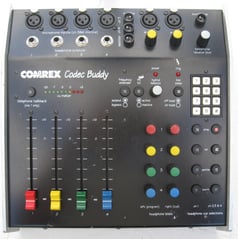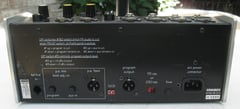Vintage Audio: Comrex Buddy Remote Mixer | Telos Alliance
By The Telos Alliance Team on Sep 19, 2016 9:44:00 AM
 Vintage Audio: Comrex Buddy Remote Mixer
Vintage Audio: Comrex Buddy Remote Mixer
During the Dark Ages, before the coming of the Internet, most remote broadcasts involved the use of leased telephone lines. Usually these lines were installed by the phone company a few days before the broadcast. Typically, they ran from the remote site to the central office (CO), and from there, to the studios. Voice grade lines were usually ordered, sometimes they were equalized, sometimes not, depending on the distances involved. The good thing about these lines is they provided a guaranteed quality of service (QoS), i.e. if they didn't work, the phone company had to make it right. The bad news was that they required advance lead time with the phone company, and there was a cost for the use of these lines and their setup. If there were weekly sports remotes, these costs could easily add up. Normally this was just added to the sports budget. But there was an alternative for the budget minded.
Dial-up lines could be found everywhere, and if you needed to order one, they were pretty inexpensive. The bad news was that they often sounded like crap. Sometimes there was hum, sometimes there was static, sometimes both. The fidelity was much worse than AM radio. Typical response was 300 - 3,000 Hz. No guaranteed QoS here. Eventually, some technological workarounds for dial-up lines began to evolve. That brings us to the subject of this month's Found in the Attic, the Comrex Buddy remote mixer.
The challenge for equipment designers was to get a more natural voice through this limited-bandwidth pipe. The solution came in 1976 in the form of a frequency extender. This device revolved around the principle that most of the natural sound of the human voice lies between 100 and 800 Hz. The trick is to shift all the frequencies up by 250 Hz at the remote end, so that 50 Hz becomes 300 Hz, and 2,850 Hz becomes 3,100 Hz. In his way, it all passes through the phone company's filters. On the studio end, these frequencies are all downshifted by 250 Hz, restoring the 100-800 Hz band.
More elaborate frequency extenders used two lines, with the second shifting the upper frequencies down by 3 Khz. The reverse was done back at the studio, and the audio from the two lines was mixed together, giving a bandwidth of around 6 Khz. Theoretically, additional phone lines and frequency shifting can be done for even better fidelity, but the cost of additional phone lines and added complexity pushes it past the point of diminishing returns.
By the mid to late 70s, frequency extenders had become affordable and commonplace. Remote broadcasts no longer sounded like they were coming through two tin cans and a string. That left just one problem, and that's where the Comrex Buddy, and similar devices came in to the picture.
The typical remote bag of the day usually included: the remote mixer, often a Sure M-67 four-channel device; a headphone amp, so that three or four broadcasters could hear themselves and each other; the frequency extender; headphones and assorted cables and adapters to connect it all together. Most announcers were not that tech savvy, and it could be a challenge to get it all set up and working. For the engineering department, that was a lot of jacks, plugs and cables to go intermittent.
The Buddy combined the mixer, headphone amp and frequency extender in one small, robust package that was easy to use. It contained a four channel microphone/line level mixer, a headphone monitor with control matrix, frequency extender, telephone coupler with touch-tone dial, and a separate PA mixer. These combo packages became quite popular, and several manufacturers had products available.
The mixer in the Buddy takes both mic and line levels on channels 3 and 4, and all faders are robust devices manufactured by Penny & Giles. Levels are indicated by a 10-segment LED display.
The monitor section determines what audio each headphone receives. The left headphone always receives program audio, while the right can be selected for each channel to feed program, incoming telephone, spotter or AUX-IN audio. Left and right headphone volumes are individually adjustable, and the knobs are color coded to match the corresponding channel fader knob.
Normally, two-way communications between the remote site and studio could only happen during breaks where the frequency extender was bypassed. Optionally, a second line could be installed so that full-time talkback was possible.
The Buddy's built-in telephone has a dial pad for making calls, and an automatically balanced hybrid to reduce level of outgoing audio into the monitor.
Frequency extenders represented a great leap forward for remote technology. Their tenure was relatively short however, as an even better technique was soon developed. POTS codecs used digital signal processing (DSP) technology to send higher fidelity audio over a dialup phone line. They quickly made analog frequen cy extenders obsolete. In the early 1990s, the Telos Zephyr brought the codec concept to ISDN circuits, and still later, IP codecs were devised to send high quality audio over the Internet.
cy extenders obsolete. In the early 1990s, the Telos Zephyr brought the codec concept to ISDN circuits, and still later, IP codecs were devised to send high quality audio over the Internet.
This Comrex Buddy was discovered at the bottom of a trash heap while cleaning up a transmitter site. The studio end was never found. It was filthy and covered with graffiti, but mechanically sound. It was in working condition, although the sound quality left a lot to be desired. The manual is available as a PDF download from Comrex. It was cleaned up, recapped, and used as a remote broadcast mixer. Since frequency extenders have long been extinct, its audio out is used to feed PA systems and external IP codecs. It now lives in semi-retirement in the attic.
Telos Alliance has led the audio industry’s innovation in Broadcast Audio, Digital Mixing & Mastering, Audio Processors & Compression, Broadcast Mixing Consoles, Audio Interfaces, AoIP & VoIP for over three decades. The Telos Alliance family of products include Telos® Systems, Omnia® Audio, Axia® Audio, Linear Acoustic®, 25-Seven® Systems, Minnetonka™ Audio and Jünger Audio. Covering all ranges of Audio Applications for Radio & Television from Telos Infinity IP Intercom Systems, Jünger Audio AIXpressor Audio Processor, Omnia 11 Radio Processors, Axia Networked Quasar Broadcast Mixing Consoles and Linear Acoustic AMS Audio Quality Loudness Monitoring and 25-Seven TVC-15 Watermark Analyzer & Monitor. Telos Alliance offers audio solutions for any and every Radio, Television, Live Events, Podcast & Live Streaming Studio With Telos Alliance “Broadcast Without Limits.”
Recent Posts
Subscribe
If you love broadcast audio, you'll love Telos Alliance's newsletter. Get it delivered to your inbox by subscribing below!